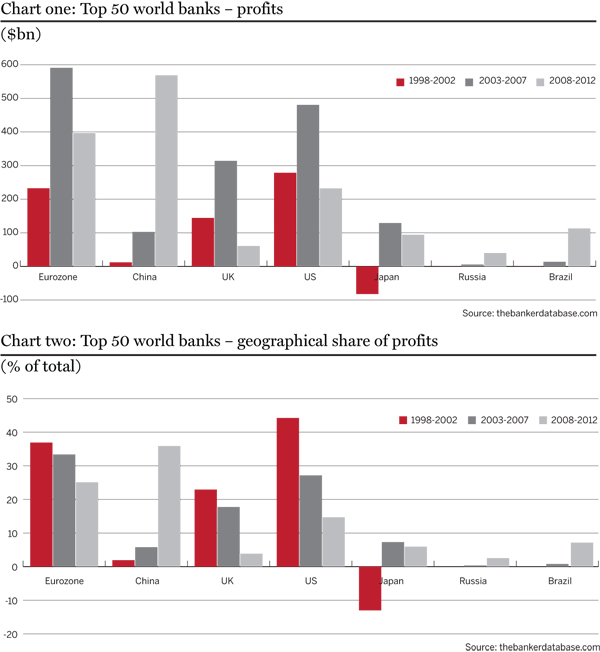Current profitability for the largest banks in the eurozone may be low compared with the US, but considering their position over the longer term, they have actually outperformed since the crisis.
The top US banks earned smaller profits in the five years following the financial crisis than they did in the five-year period a decade earlier. Total profits for financial years 2008 to 2012 inclusive for US banks that feature among the top 50 banks worldwide were $232bn, compared with $279bn for the five years from 1998 to 2002. However, this weaker performance is entirely due to 2008, a year of massive net losses for the banks among the top 50, which reached $84bn.
By contrast, although profits in 2008 to 2010 for eurozone banks in the top 50 were well down compared with the boom years of 2003 to 2007 inclusive, they were still higher than in 1998 to 2002. Although profitability has been weak since 2009, and certain banks such as Italy’s UniCredit and Germany’s Commerzbank have suffered repeated losses, top tier eurozone banks avoided the scale of losses witnessed in the US in 2008. Moreover, eurozone results are greatly buoyed by France’s BNP Paribas, which enjoyed profits in 2012 more than four times larger than the combined profits of its pre-merger constituent parts (Banque Nationale de Paris and Paribas) in 1998.
However, the most dramatic changes are in Asia. Japan’s recovery from appalling net losses in 1998 to 2002 has not been entirely derailed by the financial crisis. And China’s banks have soared, with their share of top 50 bank profits rising from just 5.8% during the Western boom of 2003 to 2007, to 35.9% in the five years post-crisis. As a result, while eurozone profits were higher in the most recent five-year period than a decade earlier, their share of global profits had shrunk from 37% to 25%.
Majority share
Eurozone profitability has arguably been relatively resilient, given the sharp deleveraging of assets among those banks in the top 50. Indeed, one striking contrast between the US and the eurozone is that European bank assets rose during the boom years as a share of the global total, at the expense of the US position. The global share of US assets for 2008 to 2012, at 15.6%, was actually higher than the peak years of 2003 to 2007, when the share was 15%. By contrast, the eurozone share of total assets tumbled from 42.6% for the five years leading into the crisis to 36.9% in the five years afterward. This is still by far the largest asset base in the world.
Meanwhile, Japan has dropped from second only to the eurozone in 1998 to 2002, to fifth in 2008 to 2012, as China overtook its Asian peer for the first time in terms of asset size.



